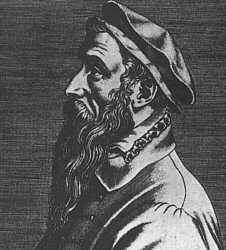
|
Bruegel's art is often seen as the last phase in the development of a long tradition of Netherlandish painting beginning with Jan van Eyck in the 15th century. This tradition transformed the abstraction of medieval art into a more empirical view of reality. Bruegel clearly rejected the influences of Italian Renaissance art and its classical foundations, which dominated the work of many of his Flemish contemporaries. Rather than mythological subjects, muscular nudes, and idealized scenes, Bruegel's art portrays figures observed from nature acting out realistic situations in believable contemporary settings.
Bruegel is thought to have come from the town of Breda, located in northern Brabant in present-day Holland. Born Pieter Brueghel, he later dropped the “h” from his name. Before he became a member of the painters' guild in Antwerp in 1551, he seems to have studied with Pieter Coecke in Brussels and worked for a short time in Malines. After a trip to Italy between 1552 and 1555, Bruegel returned to Antwerp. In 1563 he married Coecke's daughter, Maria Coecke van Aelst, and moved to Brussels, where he resided until his death in September 1569. Their two children, Pieter the Younger and Jan, both became painters of some renown.
Bruegel's earliest works were landscapes, an interest he retained throughout his life. A number of panoramic landscape drawings made on his Italian trip—for example, those preserved in Berlin (1552, Staatliche Museen) and in London (1553, British Museum)—show Bruegel's ability, even in his early career, to depict the changing seasonal moods and the atmospheric qualities of nature. These same characteristics appear in his later landscape paintings, such as Hunters in the Snow (1565, Art History Museum, Vienna) and Magpie on the Gallows (1568, Hessiches Landesmuseum, Darmstadt, Germany).
After his return to Antwerp from Italy in 1555, Bruegel regularly made drawings for engravings published by the printing house owned by the graphic artist Hieronymus Cock. Some of Bruegel's drawings for Cock were landscapes, but others were clearly meant to capitalize on the popularity of the bizarre art of Bruegel's famous Flemish predecessor Hieronymus Bosch. The fantastic, monstrous figures and demonic dwarfs in Bruegel's series of engravings The Seven Deadly Vices (1557) are within this category. Late in the 1550s, Bruegel began a series of large painted panels with complex compositions depicting various aspects of Flemish folk life. The earliest of these is an encyclopedic portrayal of common sayings, Netherlandish Proverbs (1559, Staatliche Museen), followed by Combat Between Carnival and Lent (1559) and Children's Games (1560, both Kunsthistorisches Museum). All are marked by a perceptive observation of human nature, a pervasive wit, and the vitality of Bruegel's peasant figures. Later examples of peasant folk subjects include Peasant Kermis and Peasant Wedding Feast (both 1566-1568?, Kunsthistorisches Museum).
Modern scholars are far from interpreting Bruegel's art as simple, whimsical folk subjects painted by an artist from mere peasant stock, as painter and art historian Karel van Mander described him in 1604. Recent writers see him as a knowledgeable man who was known to be a friend of such intellectuals as geographer Abraham Ortelius. Bruegel's pictures have been variously interpreted as referring to the beliefs of different religious thinkers, to the conflicts between Roman Catholicism and Protestantism, to the political domination of the Lowlands by the Spanish, and as visual equivalents to dramatic allegories performed publicly by Flemish societies of rhetoric.
|

